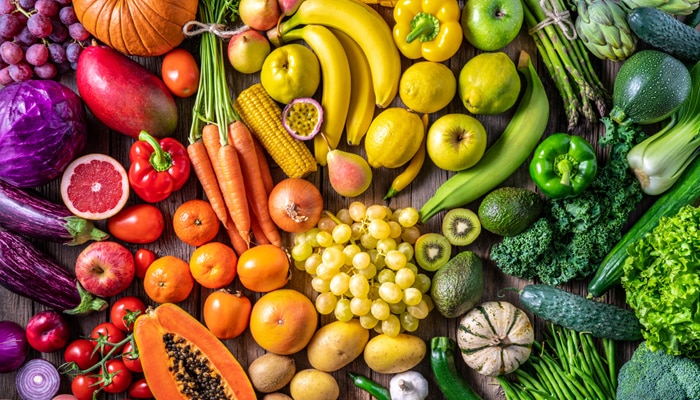While we believe that the books and resources recommended may be of value to you, keep in mind that these are suggestions only and you must do your own due diligence to determine whether the materials are appropriate and suitable for your use. PNC has no sponsorship or endorsement agreement with the authors or publishers of the materials listed.
FARM TO PRESCHOOL

Rainbow of Foods
Children will learn about the characteristics of fruits and vegetables.

Lesson Objective
Children will learn the characteristics fruits and vegetables, including size, color, shape, and texture, and that fruits and vegetables can match the colors of a rainbow.
ScienceArt
What You'll Need
- Several actual fruits and vegetables, such as oranges, pears, carrots, bananas, lemons, cucumbers, blueberries, and strawberries (make sure that the colors of the foods match the colors in a rainbow)
- Fruit and vegetables printout Download Printout
- Picture of a rainbow
- Safety scissors - 1 pair per child
- 24" by 36" sheet of butcher paper
- Glue sticks - 1 per table
- Crayons
What To Do
Note: Prior to the start of the lesson, using a pencil, lightly draw (and color, if desired) a rainbow on the butcher paper.
- Display the fruits and vegetables, and discuss with the children the many characteristics of fruits and vegetables; including color, size, shape, and texture.
- Have the children describe the color of each of the foods (see Guiding Student Inquiry).
- Ask the children if they can think of something that has the same colors of the fruits and vegetables in front of them (if no one mentions a rainbow, lead them to this conclusion).
- Display the rainbow picture, and discuss how the colors of the fruits and vegetables match the colors in the rainbow.
- Tell the children that they will be sorting pictures of fruits and vegetables by color and gluing them on paper to make a class “rainbow of foods” poster.
- Distribute several of the fruits and vegetables pictures to each child (see Lesson Tips).
- Have the children name the color of each of the food pictures and then use the crayons to color the pictures appropriately.
- Distribute scissors, and instruct the children to cut the excess paper off their pictures.
- Distribute glue sticks, and help the children glue their pictures into the appropriate color band.
- Display the rainbow of foods in your classroom.
Resources
Home School Resources
Home educators: use these printable lesson PDFs to teach this lesson to your home schoolers. They're available in English and Spanish.
Content Provided By
Common Core State Standards Initiative – These lessons are aligned with the Common Core State Standards ("CCSS"). The CCSS provide a consistent, clear understanding of the concepts and skills children are expected to learn and guide teachers to provide their students with opportunities to gain these important skills and foundational knowledge [1]. Visit the CCSS


